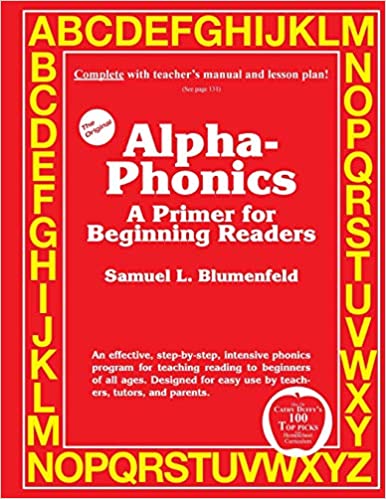Alpha-Phonics, Sam Blumenfeld’s classic phonics manual, provides comprehensive phonics instruction in a simple, straightforward manner. Rules are presented along with lists of words and syllables, and then eventually, sentences. A parent works through lessons with his or her child, working from the book. Student pages are the first part of the book. Instructional pages start on page 131.
You can add extra activities, practice readers, or games if you wish. One particular extra that is very helpful is Alpha-Phonics and How to Tutor Phonics Companion Workbook. It has fill-in-the-blank and writing activities to reinforce lessons taught from either the Alpha-Phonics book or How to Tutor.
The methodology is solid phonics. Alpha-Phonics teaches 44 different sounds for the letters of the alphabet. It teaches basic phonic rules, but not so many rules as we find in other programs like All About Reading or Foundations (Logic of English). Blending is taught via the vowel-consonant method, with initial consonants added next: e.g., "am" taught first, followed by "Sam" and "ham." Words are taught in families (e.g., an, ban, can, Dan, fan, Jan). However, many nonsense syllables are included in the early stages to help students develop phonetic fluency. Some of the practice lists of such syllables get quite silly as students read through syllables and words like: "gab, gac, gack, gad, gaf, gag, gal, gam, gan, gap, gas, gat, gav, gax," and "gaz." Students practice with quite a few such lists, but they also move quickly into reading actual sentences.
This program does not use pictures for key words as do many other programs. The intent is that students concentrate on the letters themselves so that they immediately recognize the sounds associated with a letter rather than taking an extra mental step to recall a key word associated with a picture.
The print is very large and clear with no illustrations or other distractions. The font is an unusual font that mimics printing done by hand rather than a typical font.
You will want to use other reading material for additional practice once students have actually begun to read sentences.
Also note that Alpha-Phonics recommends (but does not require) teaching cursive in the early grades before printing.
Parents must work with children through this book, but it requires no preparation time and is a very efficient, even if unexciting, way for children to learn phonics.
While the basic program would seem tailored for children who like a structured program with rules, the simplicity of it actually makes it a good foundational program for other types of learners as well since it is very easy to supplement with appropriate learning-style activities for all students.









